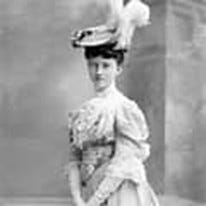Katharine Smith Reynolds
Nov. 17, 1880 – May 23, 1924
Katharine Smith was born in 1880 in Mt. Airy, NC. Her parents, Mary Susan and Zachary Smith, like RJR, had grown up on a slaveholding farm. They valued hard work and discipline and were not averse to risk taking.
More so than RJR, they respected book learning and higher education. Katharine had opportunities, denied southern women of an earlier generation, which would help her complement RJR as his partner as well as his beloved wife.
R. J. had visited his cousin, Zack Smith, when Katharine was a child. The family remembered him bouncing her on his knee. In 1890, she was 10 years old; he gave her a gold bracelet and teased her that someday he would marry her. Katharine had admirers during her college years, though she took little interest in them.
She did have one brief encounter with RJR during her early years. During a school outing to Winston, her school president asked 16-year-old Katharine and her roommate to visit RJR. While other students joined in a Tobacco Fair parade, the two girls met him to request a donation for a new Students' Building. RJR was impressed with Katharine and gave them a box of candy along with the largest single donation received for the building. This encounter likely marked RJR's first meeting with his grown-up cousin. Later, Katharine confided to her friend about her dreams of marriage, a European honeymoon, and owning a great estate, possibly inspired by her successful cousin.
Katharine, intelligent and industrious, began work at R. J. Reynolds Tobacco Co. in 1903 as a stenographer. Far from being a typical southern belle, she was an extraordinary young woman. In 18 months, she turned her initial salary of $35 a month into over $10,000 (C$350,000) of stock. Quite an achievement since less than 5% of Americans owned stock at the time. When she married, she was worth several thousand dollars.
Katharine and RJR's relationship began with mutual motives: she sought experience in a male-dominated business and independence; he possibly viewed her as a potential wife. Their employer – employee relationship allowed them to explore both possibilities.
In 2 years, she had won his heart, learned the basics of the tobacco business, and mastered modern investment techniques. RJR recognized the value of her social knowledge and cultural sense. Katharine's understanding of current fads, fashions, and consumer behavior would prove invaluable to him. His success relied on marketing skill and understanding shifting tastes.
RJR, the wealthiest bachelor in North Carolina, married Katharine in 1905. After an early-morning wedding, Katharine and RJR took a train to New York. There they boarded an ocean liner for their European honeymoon. It was a "grand tour," including visits to London, Paris, Rome, and Venice.
They attended a variety show in London that featured a segment titled "My Lady Nicotine." This highlighted the reach of their American product and enhanced their sense of importance. This European tour marked a transition for them. They entered a lifestyle of wealth and sophistication.
This trip was Katharine’s dream. and it broadened both their horizons. RJR, who had always focused on his company, embraced this new extravagance with Katharine. She changed his outlook toward cultural and consumer pursuits.
Katharine’s exposure to moneymaking and social relationships left her with a dual outlook. She had both wealth and empathy for those less fortunate. The marriage provided her with opportunities to use her influence, money, authority, and social connections to impact many lives and institutions.
While devoted to an ideal of charity, Katharine was not entirely selfless. She enjoyed extensive travels, drama, and fashion. She managed household affairs with a strong personality. Her fashion sense displayed status, wealth, and beauty. She closely followed national trends and influenced RJR’s business and social standing.
Katharine had excellent management skills. She set clear expectations for her employees and held them accountable while giving generous bonuses to top performers.
Though RJR’s company was tied to Buck Duke, his private life was not. He kept his family insulated from the national eye and focused on controlling the public image of Reynolds Tobacco Company. While he had a more modest personal style than Katharine's lavish tastes, he was a striking figure, especially when dressed for public outings. He chose a practical, yet fashionable, mink-lined greatcoat, a balanced approach to displaying wealth.
Katharine and RJR soon began a family despite doctors’ warnings that childbirth could threaten her health. A son, Richard Joshua Jr., was born in 1906, followed by two daughters, Mary Katharine and Nancy Susan in 1908, and 1910, and a son, Zachary Smith in 1911.
Initially, the family lived on West Fifth Street in a palatial Queen Anne mansion. Fifth Street was called "Millionaires’ Row" due to the number of Reynolds family members, high-ups in R.J. Reynolds Tobacco Company, and other tobacco and textile industrialists who lived there. But Katharine had far bigger dreams than the house in Winston.




Nice story, looking forward to the next one!
You write very well. I like that you nerd out on the tobacco industry. Your depth of knowledge adds color and context to a potentially very dry subject matter. Please keep it up.